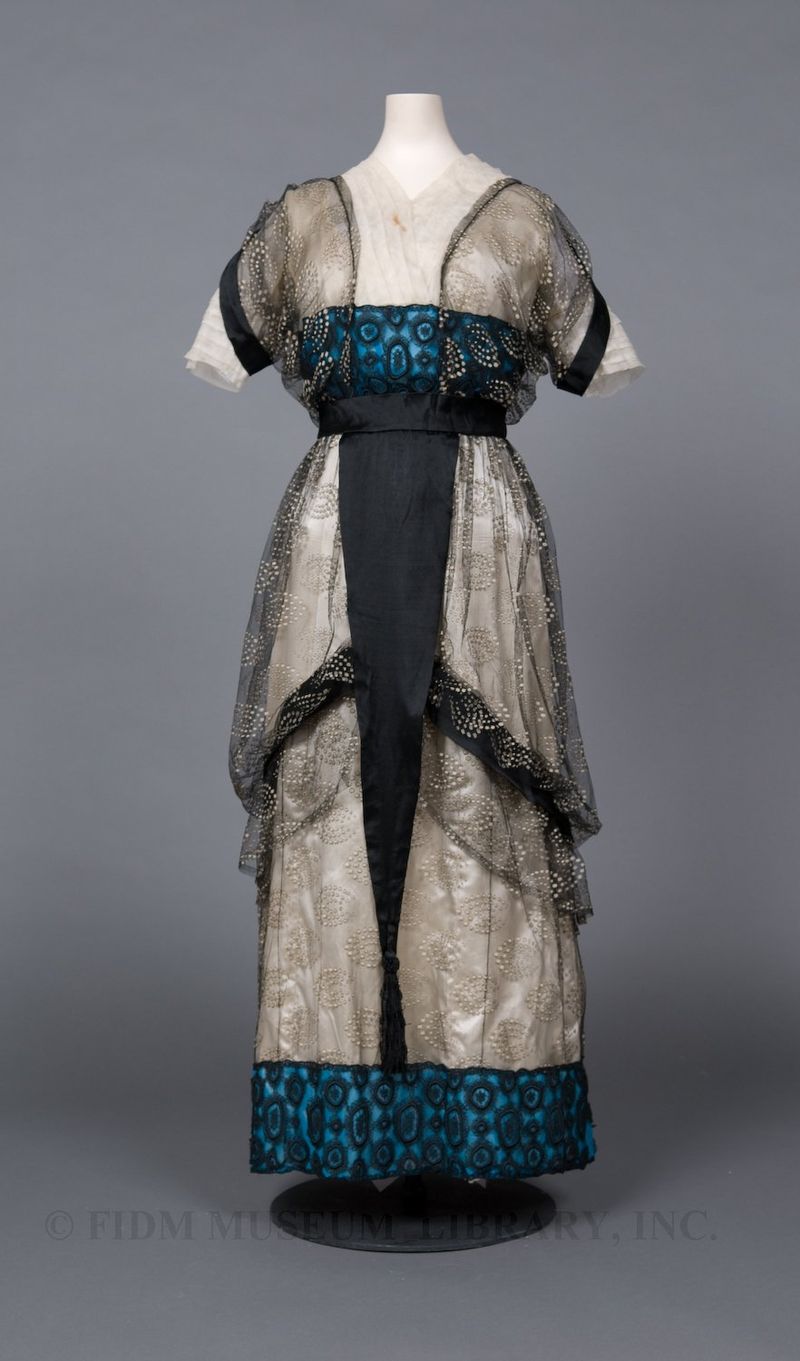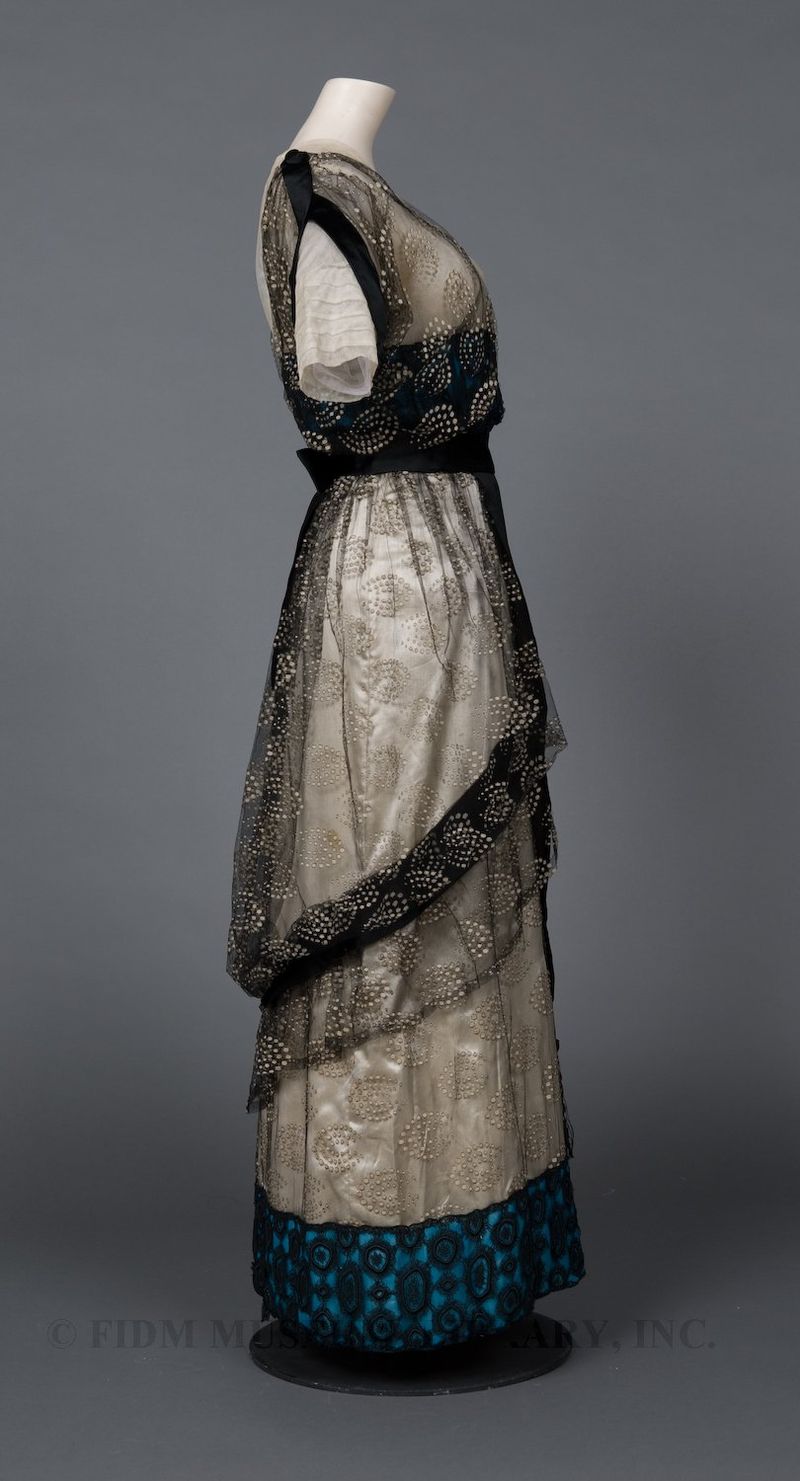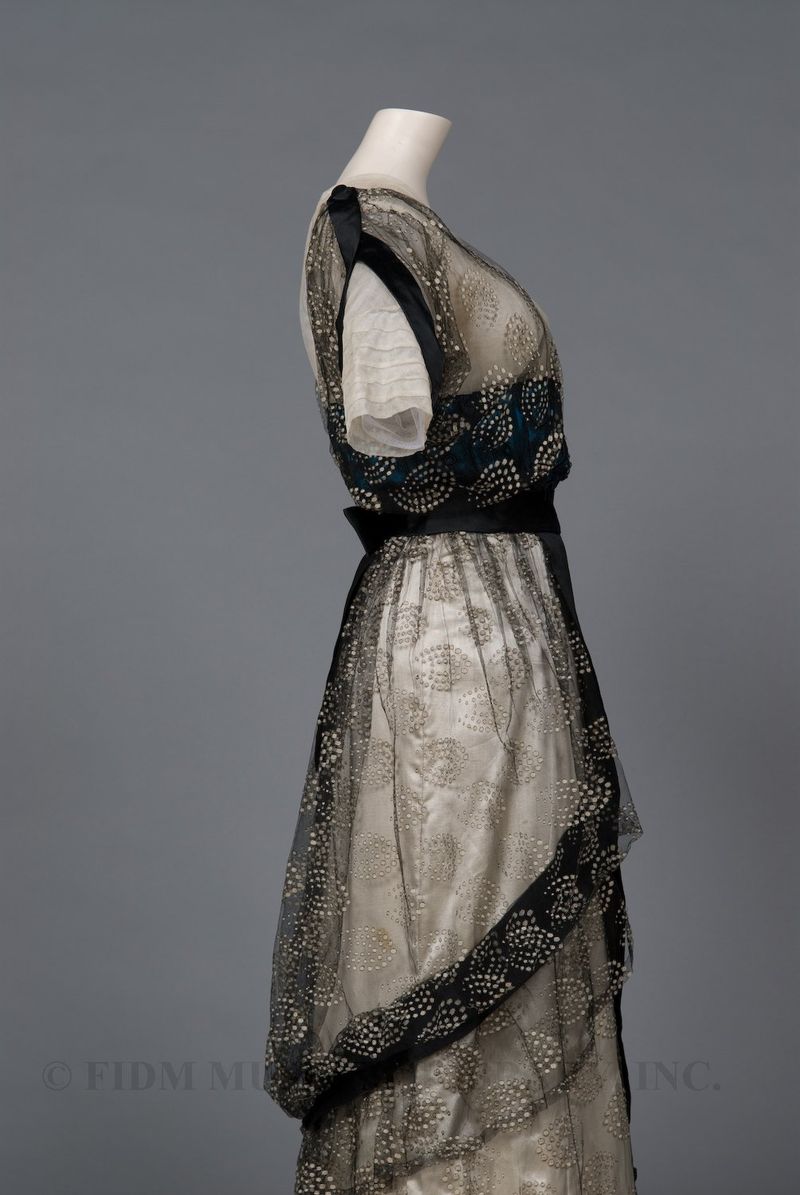In 1912, fashionable dress was a combination of classical and orientalist elements. The silhouette was slim and high-waisted with an emphasis on the vertical line. A draped surplice bodice, waist sash or overtunic provided the requisite touch of drapery. These elements were drawn from ideas of ancient Greek and Roman dress as filtered through the Directoire style (itself a revival of Greek and Roman dress) of late eighteenth century France. Conceptions of Middle and Far Eastern dress were expressed through the popularity of jewel-toned textiles. Popular accessories, including jeweled and feathered turbans, also borrowed heavily from the Far and Middle East.
 Tunic dress
Tunic dress
c. 1912
Museum Purchase
2000.5.1
Structurally, classical and orientalist dress shared a lack of emphasis on re-shaping the human body. This was dramatically different from western dress, which for centuries had focused primarily on forcing the body into the desired silhouette through careful shaping or rigid understructure. Though this particular element of classical and orientalist dress had enjoyed sporadic and/or subcultural popularity for many centuries, it started to gain widespread popularity about 1908-9. This was perhaps a response to the highly stylized S-bend (bust forward, hips back) silhouette popular from 1900.
This interest in the (somewhat) natural body meant that fewer undergarments were required to achieve the fashionable silhouette. With the popularity of the slim line, fewer petticoats were necessary. One-piece slips, composed of a camisole top and slim petticoat, became popular. Though many women continued to wear corsets, they became gradually less restrictive. Paul Poiret often claimed the credit for this more “liberated” style of dress, but it would be more accurate to say that he capitalized on an existing trend towards more freedom of movement in dress. Though Poiret might have overstated his role in creating this less-restrictive silhouette, his aesthetic was extremely influential. The FIDM Museum dress seen here, though lacking any information about maker or origin, borrows heavily from Poiret’s designs of the same period.
The evening dress seen here adheres closely to fashion descriptions and illustrations dating to c. 1912. A December 1911 article in Harper’s Bazaar described the popularity of “the draped surplice bodice with the V-shaped yoke [and] elbow-length sleeves.”1 Both day and evening dresses featured tunics, though tunics on evening dresses were often of sheer chiffon, sometimes embellished with beads or spangles. The black chiffon tunic on this dress is decorated with white polka-dots, placed in concentric circles. As demonstrated here, the sheer tunic creates a rich, layered effect, a hallmark of orientalist dress. It also softens what could otherwise be a severely vertical silhouette.
Both the hem and waist of the dress are banded by turquoise chiffon with an overlay of black lace. The dress would hit at the instep, not quite covering the foot entirely. This length was considered more youthful than a floor-length trained evening dress and required matching slippers. In a January 1912 article title “Inexpensive Frocks,” Harper’s Bazaar encouraged young women to not shy away from the cost of an extra pair of slippers, which would ideally match the gown. If a matching pair were too expensive, black slippers worn with black stockings were a “safe substitute.”
1 “New Evening Gowns.” Harper’s Bazaar Dec. 1911: 45.
>br>





Such a gorgeous gown.
But the silhouette I feel, does reflect the restless mood of the 1910s.
Evangeline, could you elaborate on your comment? I’d like to know why you feel this dress reflects the mood of the teens. Would love to hear your thoughts!
How do I UNSUBSCRIBE TO THE BLOG? I erroneously subscribed twice. You should have a ‘manage your subscription’ button, which I cannot find.
Thank You,
Kay E.
Hello Kay,
Our subscription is in the form of an RSS feed. So, when you click on the “subscribe” link, you’re adding our blog to a reader. We don’t send updates to your email inbox. If you use Google as your search engine, updates to our blog can be found under “Favorites,” sub-category “Feeds.” If “FIDM Museum Blog” appears more than once under your “Feeds,” just right-click the mouse and then delete one of the feeds. If you use Firefox, “FIDM Museum Blog” will appear in the middle of your toolbar. Again, right-click the mouse and then delete if our feed appears more than once.
Hope this information helps! If you have any additional questions, feel free to email me directly at rharris@fidmmuseum.org
I am so drawn to this dress. It’s really lovely.
Becky, I think fashion from this era is sometimes overlooked, as it came right before the “Roaring ’20s.” But, dresses of this style/era are so lovely!
So what, exactly, would be worn under a gown like this?
Carmen, you are asking about undergarments, correct?
This was a transitional period when undergarments were changing. Many women probably continued to wear long-line corsets, which start below the bust and encase the waist and upper thighs. This type of corset would have been worn with a chemise or combinations worn under the corset. Some women probably wore an early style of bra with separate drawers under their corsets. A slim petticoat, or maybe a princess-line slip, would have been worn over these undergarments.
You can see a 1908-10 bra here: http://blog.fidmmuseum.org/museum/2010/12/brassiere-1908-1910.html
And a 1900-1910 combination undergarment here: http://blog.fidmmuseum.org/museum/2010/10/combination-undergarments.html
Hope this information answers your questions.
I actually have one of his dresses. I don’t know anything about it and have it listed on ebay right now. Would love some information. hermanhorwath@sbcglobal.net
ty shirley
I absolutely adore this dress. I chanced upon your website while I was looking for a dress circa 1912 to make for a Titanic 100th anniversary dinner I’m attending. This is the one! I’m going to try to copy it as closely as possible and hope I do it justice. Thank you for all the written information you provide, including links to the period underwear. Not sure I’ll be wearing drawers though!
Sadly I can’t visit your museum as I live in Australia, but will definitely come and find you if I’m ever in LA.